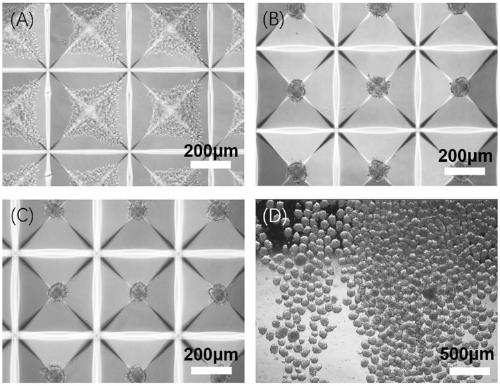Pancreatic-like structural body and construction method and application thereof
A construction method and structure technology, applied in the field of pancreas-like structure and its construction, can solve the problems of poor controllability, inability to achieve high-throughput stable preparation and high-throughput screening, etc.
- Summary
- Abstract
- Description
- Claims
- Application Information
AI Technical Summary
Problems solved by technology
Method used
Image
Examples
Embodiment 1
[0082] Embodiment 1 Biological material stock solution preparation
[0083] Gelatin solution: mix gelatin powder (Sigma, G1890) with 0.9% sodium chloride solution at a mass ratio of 15:100, vortex the solution for 1 minute, heat at 60°C for 2 hours, and repeat the shaking The operation of vortex and heating was performed twice to finally make it dissolve evenly, then aliquoted and stored at 4°C. Incubate in the cell culture incubator for 10 minutes before each use to make it melt into a homogeneous solution.
[0084] Sodium alginate solution: mix sodium alginate powder (Sigma, A2033) with 0.9% sodium chloride solution at a mass ratio of 4:100, vortex the solution for 1 minute, and heat at 60°C for 2 hours. Repeat the operation of shaking, vortexing and heating twice again to finally dissolve it evenly, and store it at 4°C.
[0085] Matrigel: Matrigel (Corning, 356234) was thawed at 4°C, aliquoted on ice, and stored at -20°C. Thaw at 4°C before use and use within 24 hours. ...
Embodiment 2
[0086] Example 2 Stem cells and vascularized cell culture
[0087] Human adipose-derived stem cell (Adipose-derived stem cell, ADSC) (Sciencell, 7510) was cultured in the ADSC cell expansion medium, and the ADSC cell expansion medium was carried out according to the MSCM medium kit (Sciencell, 7501). Preparation; the culture bottle was pre-primed with PLL solution (Sigma, P4832) diluted 8 times with sterile water, and the bottom was primed for 1 hour; when the cells were 90% confluent, they were passaged at a ratio of 1:3, and the culture medium was replaced every 2-3 days.
[0088] Human umbilical vein endothelial cells (human umbilical vein endothelial cell, HUVEC) (ATCC, PCS-100-010) were cultured in HUVEC cell expansion medium. HUVEC cell expansion culture medium was prepared according to the EBM-2 medium kit (LONZA, CC-3162). When the cells were 90% confluent, they were subcultured at a ratio of 1:3, and the culture medium was changed every 2-3 days.
Embodiment 3
[0089] Example 3 Stem cells are pre-differentiated in a multi-well plate
[0090] ADSC cells of passage 4 were used for differentiation. Use the method above to prime common 24-well plates before differentiation. After ADSC cells were digested with 0.25% trypsin / EDTA (Gibco, 25200) digestion solution, the cell pellet was collected by centrifugation at 1200rpm for 5min, and the cell pellet was collected at 2×10 5Cells / ml were suspended in ADSC cell differentiation medium to obtain ADSC cell solution, and 1ml of ADSC cell solution was added to each well of a 24-well plate. The composition of the differentiation medium is in the mixed DMEM medium (Gibco, 11965) and DMEM / F-12 medium (Gibco, 11320) of 1:1 volume ratio, add 10mM Nicotinamide (Sigma, 72340), 2nM Activin A (R&D, 294-HG), 10nM Exendin-4 (Sigma, E7144), 10nM Pentagastrin (Sigma, B1636), 100pM hepatocyte growth factor (Sigma, SRP6014), 2% B-27 supplement (Gibco, 17504), 1% N-2 supplement (Gibco, A13707), 1% penicillin...
PUM
 Login to View More
Login to View More Abstract
Description
Claims
Application Information
 Login to View More
Login to View More - R&D
- Intellectual Property
- Life Sciences
- Materials
- Tech Scout
- Unparalleled Data Quality
- Higher Quality Content
- 60% Fewer Hallucinations
Browse by: Latest US Patents, China's latest patents, Technical Efficacy Thesaurus, Application Domain, Technology Topic, Popular Technical Reports.
© 2025 PatSnap. All rights reserved.Legal|Privacy policy|Modern Slavery Act Transparency Statement|Sitemap|About US| Contact US: help@patsnap.com



